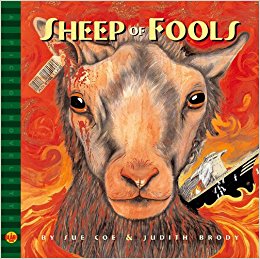In 1844, a Frankfurt physician named Heinrich Hoffman (sometimes known as the “medical man of the lunatic asylum”) went into town to buy a children’s book for his three-year-old son. He found nothing but what he called “stupid stories, beginning and ending with admonitions like ‘the good child must be truthful’.” Irritated by the poor selection, he wrote and illustrated his own collection of children stories called Struwwelpeter (translation: Shockheaded Peter), which he gave to his son for Christmas. They are some of the most horrific, brutal stories ever to be considered juvenilia, and they mark the genesis in a long tradition of unusual art books.
Fantagraphics has just released a new edition of Struwwelpeter, which it is calling “the world’s most nightmarish children’s book.” This edition is illustrated by artist Bob Staake (MAD, Cartoon Network), who remembers, “When I was given the book as a kid I didn’t know if it was a joke or not, but my German parents weren’t laughing.” Staake’s art, which is 100 percent digital, lies somewhere between Pop Art’s sterile cleanliness, South Park’s cut-and-paste characters, and Wassily Kandinsky’s bright color slabs. It has the sort of vibrant, immediate energy that is generally associated with candy wrappers and billboards, yet most of the imagery involves bloody, dying children. This edition of Struwwelpeter is one of the first in a new line of books called the Blab! Storybooks, a series that caters to a strain of bizarre illustrated literature that eschews the formats of accepted genres (art book, comic book, graphic novel, children’s book) and explores new, hybridized forms. The series includes new work by gallery artists, illustrators, and cartoonists such as Camille Rose Garcia, Drew Friedman, and David Sandlin.
Struwwelpeter is a collection of short poems about children who are violently punished for disobedience. Little Pauline plays with matches, sets herself on fire, and burns to death as her cats watch. Augustus, a finicky eater, refuses to eat his soup and very quickly dies of debilitating starvation. A thumb-sucking child’s thumb is amputated by someone called the Scissorman; young boys drown; racist white children are dipped in black ink, and an evil, animal-abusing child called “Cruel Frederick” is mauled by his pet dog. Most slasher films would be more appropriate entertainment for the average child. This is the beauty of Struwwelpeter: it is a book completely...
You have reached your article limit
Sign up for a digital subscription and continue reading all new issues, plus our entire archives, for just $1.50/month.
Already a subscriber? Sign in





